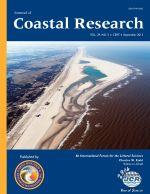Peterson, C.D.; Gates, E.B.; Minor, R., and Baker, D.L., 2013. Accommodation space controls on the latest Pleistocene and Holocene (16–0 ka) sediment size and bypassing in the Lower Columbia River Valley: a large fluvial–tidal system in Oregon and Washington, USA.
In this study, we establish the roles that increasing basin accommodation space have on sediment size and bypassing in the transgressive fill (16–0 ka) in the submerged Lower Columbia River Valley (LCRV). The antecedent forearc valley (225 km in length, 4–8 km in width, and 60–115 m in axial valley depth) is characterized by high sediment supply rates (10–15 million t y−1) but no delta at its mouth to the Pacific Ocean. Core sample sediment textures (N = 1600) are analyzed from 3000 m of borehole sections in 58 representative boreholes to characterize the ancestral valley fill: 57% sand, 17% muddy sand, 12% sandy mud, and 14% mud (total fill volume = 77 km3). Decreasing mud endmember texture from between 30 and 60% (early Holocene) to 18% (late Holocene) is directly related to (1) declining rates of increasing basin accommodation space and (2) increasing sediment bypassing through the LCRV. Both conditions result from decreasing rates of sea level rise (15.0–1.5 mm y−1) in Holocene time. The overall coarsening of sediments, both upvalley and upsection, is controlled by declining rates of increasing basin accommodation space (5.66 million–0.57 million m3 y−1) during middle to late Holocene time. Differences between middle and late Holocene sediment accumulation rates yield bedload bypassing rates of 5– 6 million m3 y−1, under assumed conditions of constant sediment supply rates in middle to late Holocene time.





